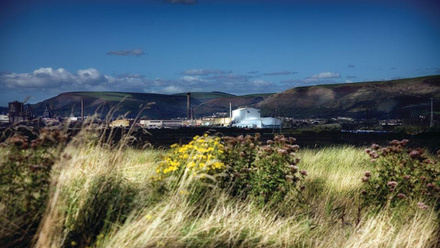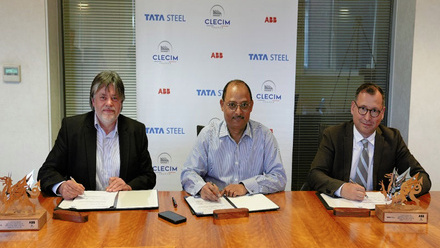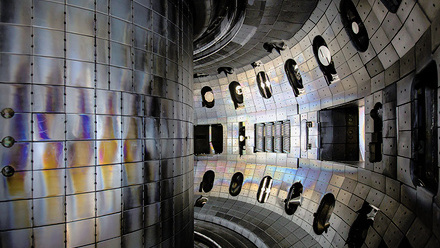Surviving in a global market
A spotlight on the global steel market and how the UK fares

Today, we are experiencing a culmination of forces – from technological advancements, economic pressures within industry and academia, to environmental regulations and, most recently, global trade dynamics – that are stress-testing the steel sector unlike any other time before.
The UK steel industry is currently navigating through a transformative period marked by a shift from traditional blast-furnace steelmaking to the electric arc furnace (EAF) as part of the country’s net-zero journey.
However, in the last 10 years – according to the World Steel Association (WSA) – total UK crude steel production has steadily declined from 12.1Mt to 4.0Mt in 2024. The closure of Tata Steel UK’s last blast furnace (No.4) at Port Talbot in September 2024, left the UK with two remaining operational units at British Steel, Scunthorpe, which were also facing closure until the UK Government stepped in recently.
In sharp contrast, in this period, global crude steel production grew by 175Mt to reach 1,840Mt – according to the WSA – with China accounting for 1,005Mt, followed by India at 150Mt – which itself has ambitions to reach 300Mt by 2030.
Peak output from China was seen in 2020 at 1,065Mt. This was a staggering 56.7% of total world output. Leading to this, nearly 260Mt of new capacity was installed over a four-year period. This was largely driven by government guidelines, originally implemented in 2015, to support the replacement of old steelmaking facilities with new ‘capacity swap’, and aiming to slim down capacity by phasing out ineffective, unprofitable steelworks and promoting mergers and acquisitions.
However, this mechanism actually led to rapid expansion, as the new facilities were far more productive than those being replaced and some of the obsolete facilities were already inoperable.
Today, the top 20 Chinese steel producers account for nearly 30% of global steel output, and the Chinese Ministry of Industry has indicated its desire that China’s top 10 steel producers should aim to hold 60-70% of its domestic industry capacity. This would bring a significant global market and economic power to a handful of newly created steel titans.
Since 2020, Chinese crude steel output has seen a reduction of 60Mt, coupled with increased steel exports of more than 110Mt in 2024. This has largely been attributed to a slowing domestic market and a decline in the capacity replacement of blast furnaces.
For example, in 2024, a total of 24 new blast furnaces were installed equating to 33Mt, which directly replaced 42 units equating to 42Mt. However, 2025 expectations, reported by the Shanghai Metal Market, say that a further 18 new units will be installed at 26Mt total capacity, but will only replace 22 units equalling 16Mt.
It is worth noting that the Chinese Government has stated it expects to reach peak carbon output by 2030 and neutrality by 2060. To support this transition, in 2023, the government proposed that 15% of the country’s total steel output should be derived via EAF routes by 2025 and reach over 20% by 2030.
The latest update in 2024 revealed that only 10.5% had been achieved, partly due to insufficient steel scrap availability and recycling infrastructure, as well as the economic risk for many steelmakers in having stranded assets.
In comparison, the Government of India has set a goal to be carbon neutral by 2070. However, the Indian steel industry is aiming to achieve neutrality by 2047, with Tata Steel setting a goal to be net-neutral in carbon emissions by 2045. With the industry dominated by five large players, there is optimism that this 2047 target is achievable.
Steel hope
For some perspective, in 2024, the UK accounted for <0.22% of global crude steel output and <0.26% of global steel industry CO2 emissions, according to approximate calculations based on UK crude steel output and the WSA’s Sustainability Indicators 2024 report.
Here in the UK, under the auspices of the Department of Business and Trade (DBT), the recently formed UK Steel Council represents a significant step towards addressing the challenges and opportunities facing the industry.
In mid-February 2025, DBT published a consultation paper inviting stakeholders to provide input into the formulation of a UK Steel Strategy. As Chair of the IOM3 Iron & Steel Group (ISG), I am delighted that the ISG Leadership Team informed the IOM3 response with inputs from members.
The output and, moreso, the actions from this consultation paper are eagerly awaited in the coming months. Hopefully, it provides much needed clarity towards a targeted and tangible delivery of the UK Government’s £2.5bln investment plan for a sustainable and competitively viable UK steel industry.
While it can be debated that the financial intervention has been long overdue, it has to be recognised that, for capital-intensive industries, such sums are intended as stimuli and will require ongoing commitment at various levels from all parties involved. It is anticipated that some of this will also feed through to the UK’s steel R&D community and even attract much needed inward investment from disruptive technology enterprises.
Strong roots
The UK’s steel science and technology base has roots extending well over 170 years. It has consistently demonstrated the valued synergy that exists between research and commercial manufacturing success. This proud heritage must be sustained as the industry invests and seeks new technologies and pathways to achieve the challenges before us, such as the increased use of scrap steel.
Indeed, the EU recently allocated €100mln to boost steel research on a ‘big ticket’ call via the Research Fund for Coal and Steel funding programme. It is vitally important that our scarce resources are marshalled with care and focused on identified critical needs to ensure the industry’s long-term sustainability and growth.
The renewed emphasis on the UK Steel Charter, first launched in 2019 to change procurement processes to include more UK-made steel, is another positive step, as well as current considerations to increase expenditure into renewable infrastructure, grid expansion for greater electrification and investments into the UK defence sector.
While focus is heavily centred upon decarbonisation, we must also not overlook investments into rolling mill technologies, especially the UK’s plate mill capability, and to consider our domestically generated steel scrap as a strategic resource.
Mission critical within this all is the need for talent retention, recruitment and development in subject matters that align with current and future industry needs. Ranging from metallurgy and materials engineering through to computer and digital sciences, artificial intelligence and digital/cyber security. Recent world events are highlighting both the strengths and weaknesses of our existing construct in several areas.
Indisputably, the path ahead is fraught with uncertainties. The landscape continues to evolve and today we literally do live in unprecedented times.
However, through collaboration and engagement from our steel community and eco-system, together with focused strategic investment, the UK steel industry can navigate these challenges for a brighter and sustainable future.











